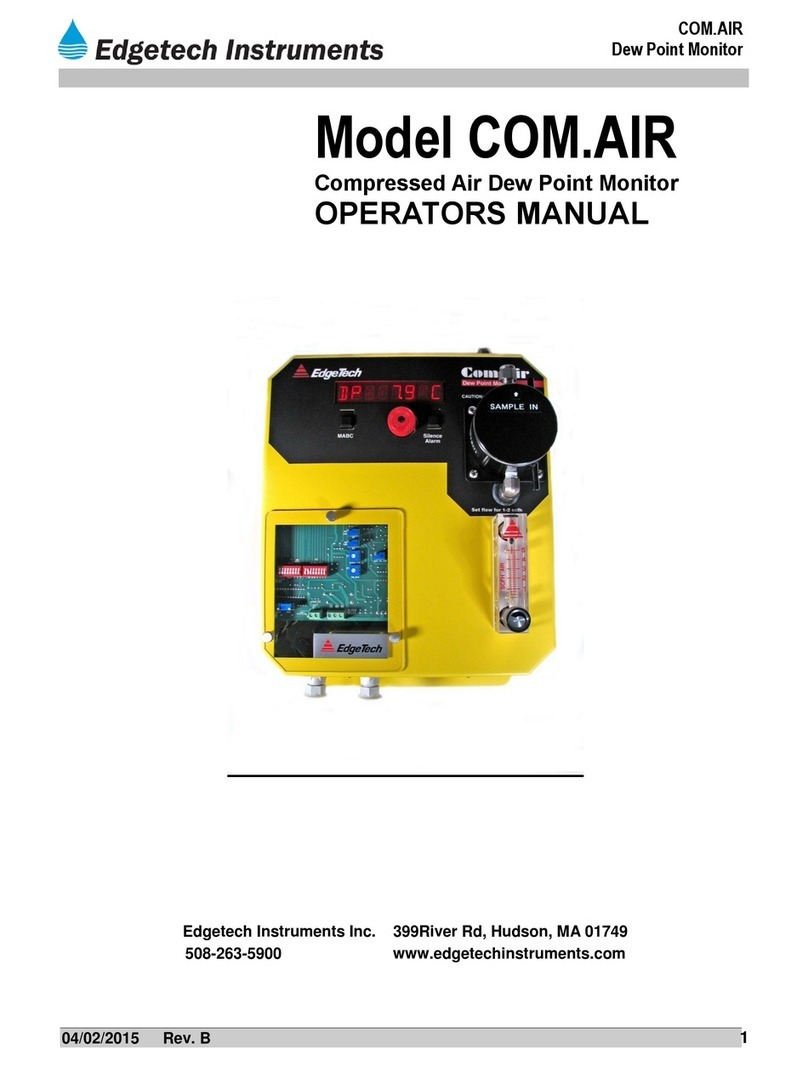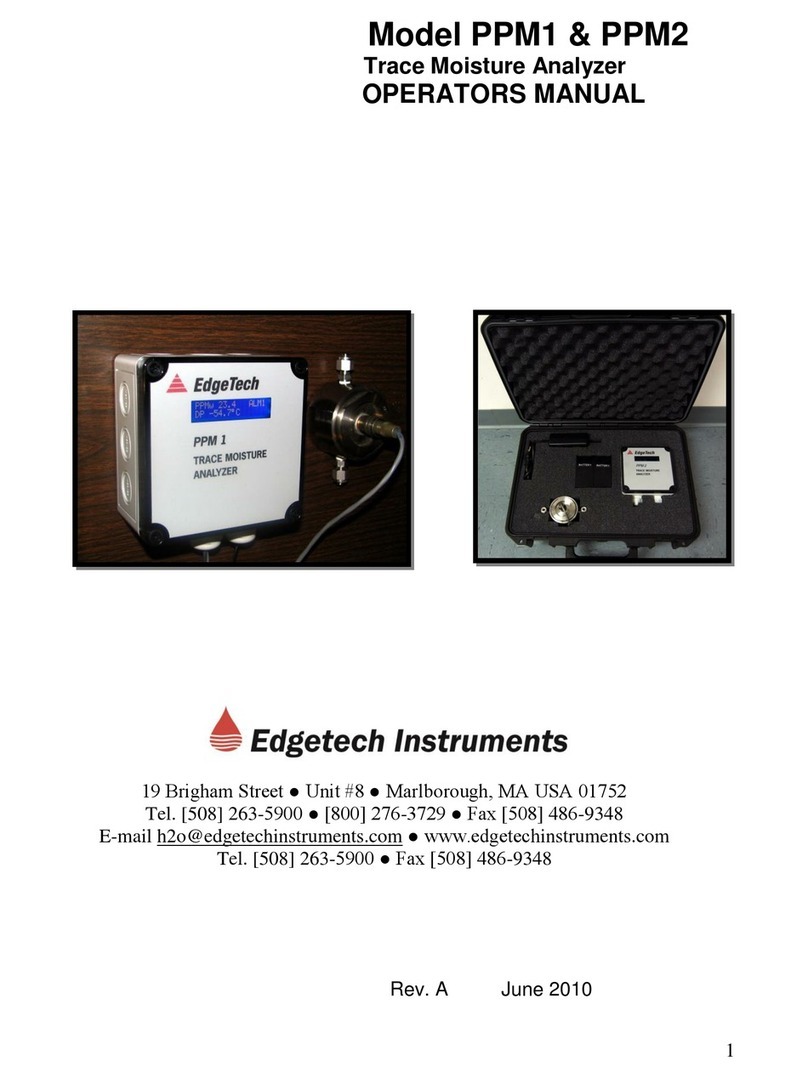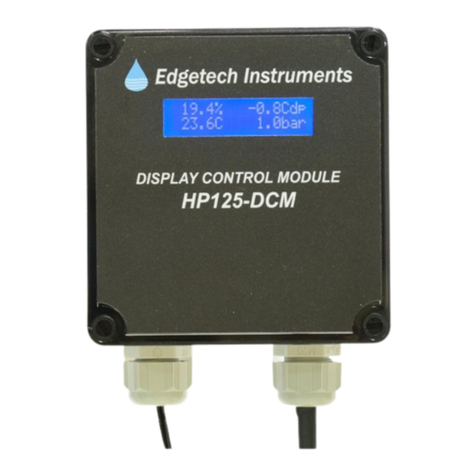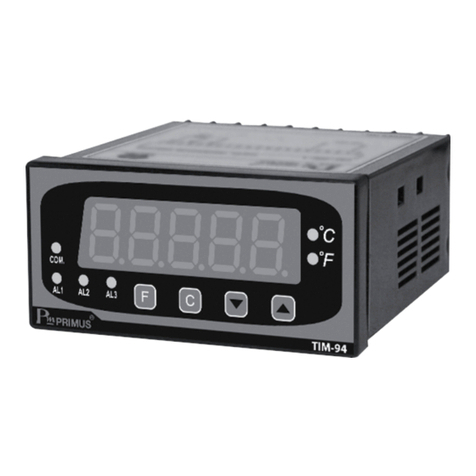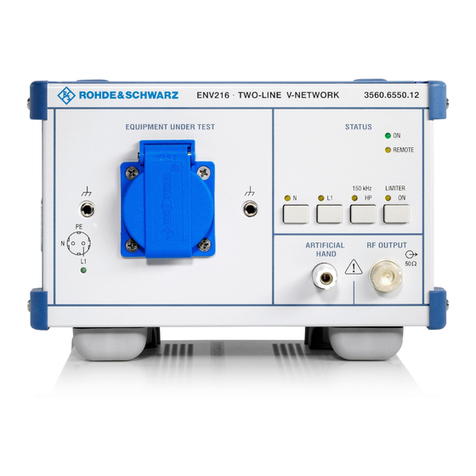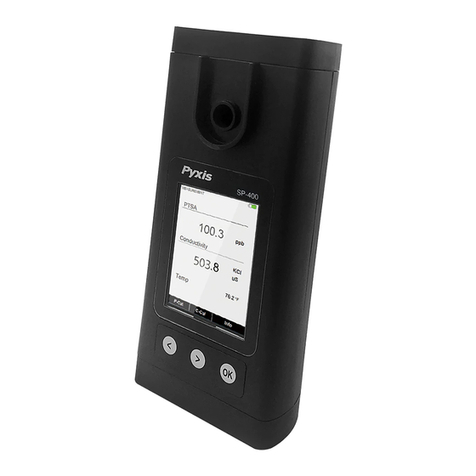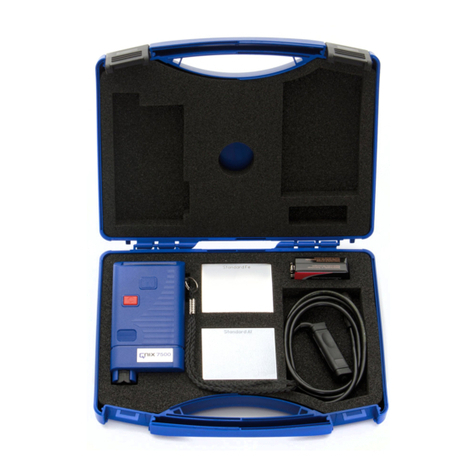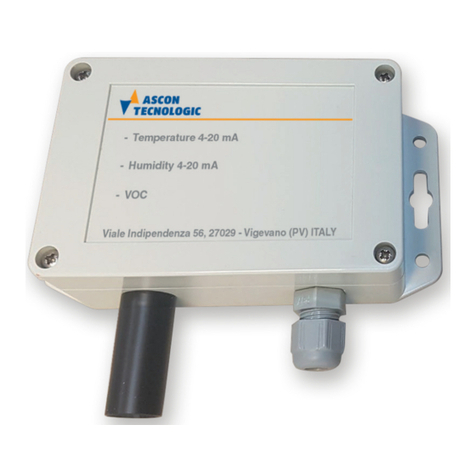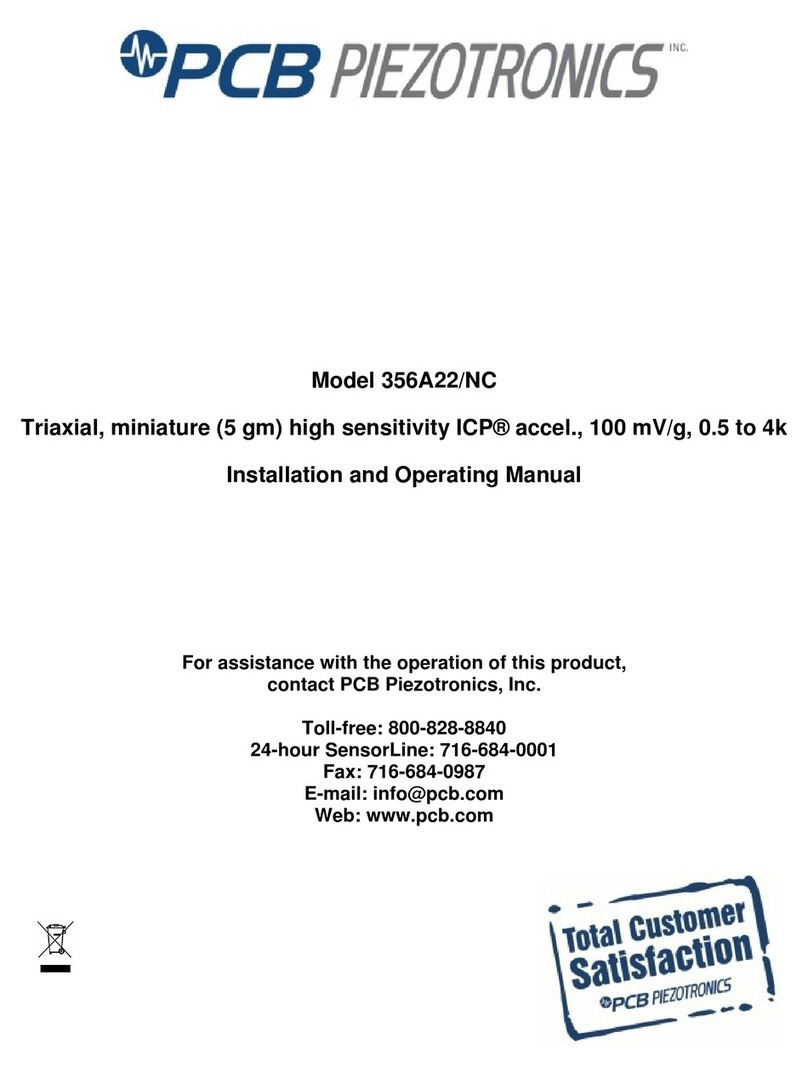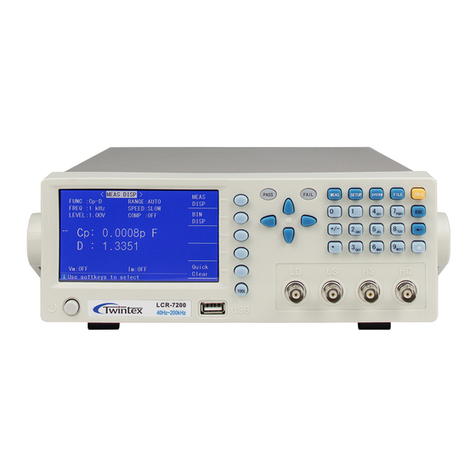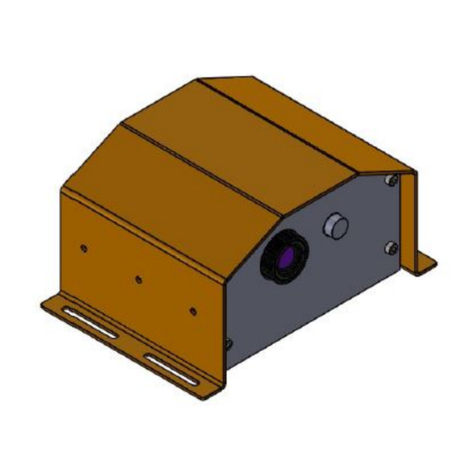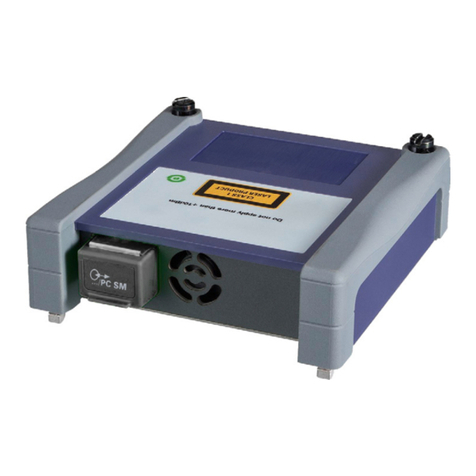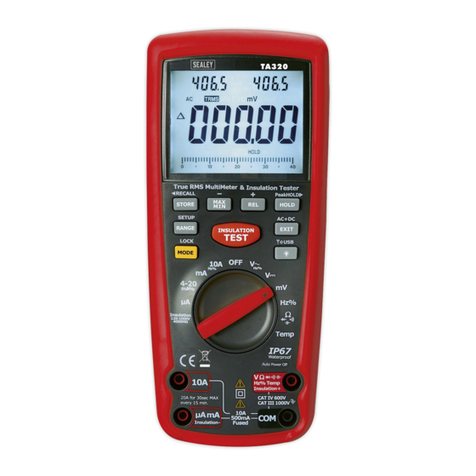Edgetech 2000 Series User manual

MODEL 2000 SERIES
DEWPRIME
DEW POINT
HYGROMETER
OPERATOR'S MANUAL


v
i
i
Model
2000
Serie
s
DewPrime
Dew
Poin
t
Hygrometers
Page
THEORY OF OPERATION.
.
.
.
...
.
..
..
.....
.
....
.
..
....
.
.....
..
.
....
.
.
.
.
.
.
.
...
....
..
.
.
..
..
..
...
..
..
......
..
.
.
.
.
.
...
..
.
...
.
.
..
..
..
.
.......
.
......
4-1
4.1
SYSTEM OPERATION.......
.
.
..........
.
..
.
.
.
..................
.
....
.
...
..
......
.
..
..
...
.
...
.
.......
..
...
.
....................
.
.......
4-1
4.1.1 Main
Control
Loop..
..
.
..
..................
.
..................
..
..
.
.........
.
...
.
.
.
..
.
.
.
...........
.
.
.
..
.
.....
...
....
.
..
.
.
...
...
4-1
4.1
.
2
Temperature
..
..
.
.
.
.....
.
..
.....
.....
..
.......
....
.
.
.
.
.
...
..
............
..
..
.......
...
...
...
..........
.
.
.
...
.
..
..
....
.
....
.
....
..
.
..
.
.
..
4-1
4
.
1
.
3
Automatic Balance Control.....
..
..
.
.
..
.
.....
.
..
..
..
...
....
..
.
......
..
.
....
..
...
.....
..
.
........
.
..
.
..
.
.......
...
.
....
..
.
...
4-
1
4.1.4
Microprocessor
Control............................................................................................
.
..
........
4-1
4.2 CIR.CUIT
DESCRIPTIONS...................
.
.
...
.
..............
.
..
.
.
.
............................
.
........
.
..................
..
....
4-1
42.1
Thermoelectric
Dew
Point Temperature Control
Circuits....
.
.
............
.
.
.
..
.
......
.
...
.
..
.
..
.......
.
.
..
. 4-1
4.2
.
2
Sensor
PRT Resistance-t<rVoltage
Converter
....
.
.
.
..
..
..
....
.......
..
.
.
...
.......
......
.....
.
....
.
...
....
.
..
.
..
4-3
4.2.3
Automatic Balance Control Circuits.................
.
..
.
...
....................
..
...........
...
.............
......
..
..
4-3
42
.
4
Alarm Setand
Protection
Circuits........................
.
.
..........
.
......
.
....................
...
..
.
........
..
.
...
..
4-3
4.2.5 Display
Circuitry...
.
....
..
.
.............
.
..
..
.
...
.....
.........
.
.
.
.
.
.
.
..................
.
.
.
...
.
.................
..
......
......
.
..
...
4-4
4.2.6
Track
or Hold
Circuitry
....
....
.
........
....
......
.
..
.
.
....
...
..........
.
.....
...
...
.....
......
.
..
..
..
..
..
.
......
....
.
.
.
....... 4-4
MAIN1'ENANCE
AND C
RATION............................................
.
................
.
....
.
...........................
5-I
5.1
ROlJTINE MArn'IENAN"CE
.
.
.
...........
...
...
...
..
.........
...
.
.
......
..
.........
......
......
.
...
......
......
...
........
.
.
..
..
..
..
.
5-l
5
.
2
OR
CLEANmG
SClffiDUI..E.........
..
...
.
......
.
.
...
.
....
.......
..
..
..
........
..
.........
.
.
.
..
.......
.......
..
....
.....
..
5-1
5.3
OR
CLEANmG....
.
.
........
..
.........
..
....
..
..
....
..
...
.....
......
..
.
..
..........
..
..
..
.
...
....
..
.....
..
..
..
........
..
..
..
..
...
5-1
5
.
4
CALffiRATION
OF
PRT
..
..
..
..
..............
........
.
..........
....
..
...
..
.
...
.
.
..
.
..
.....
..........
.
..
..
...................
.
..
.
....
.
5-l
5
.
5
CALIBRATION OF
THEPRT
AMPLmER..........
.
..
...
..
...
..............
....
.
..
.............
.
....
.............
......
..
..
5-2
5
.
6
OPERATlN'GADJUS'J'IIdENTS
........
....
.
......
....
.
.
.
.
..
.......
..
.....
.
.
..
......
......
...............
.
..
.....
...........
......
..
.
5-2
5
.
6
.
1
Balance
for S2
Sensor.....
.
....
...............
.....
............
.
....
..
.....
.
.
.
..........
.....
..
...
..
..
.
.
..
..
....
...
.....
.
..
....
5-2
5
.
6
.
2
Balance
for Sl
Sensor....................
.
..
.
.................
.
.......................................
..
.......
.
...
..
..........
5-3
5
.
6
.
3
Thickness..
..
..........................................
.
................................
..
...
..
....................
.
.........
.
..
.
....
.
5-3
5
.
6.4
Gain
.
....
.
.
...
.
....
.
.
.
..
.....
....
.........
....
.
............
.
...
....
....
.....
.
.......
..
.
..
...
..
...
....
..
...........
..
....
.
...........
.
.
.
..
...
..
5-3
5
.
6.5
Compensation..
.
.
.
....
..
.
..
.
......
.
..
....
....
.
.....
...
...
.
...
...
.
.
.....
.
.
..
.....
.
..
......
.
.
..
..
..
.
.....
..
.
.
.
..
.
..
.
..
.
..........
...
.
.
..
..
54
5
.
7
'WET1'ED
PAR.TS.
.
.
.
.
...........
.
....
.
.............
..................
..
..............
.
.
.
...
.
..............
..
...
..
......
.
..
...............
.
...
5-4
5
.
8
SUGGESTED SPARE
PAR.TS
..
...............
..
..
............
.
....
..
.
..
..........
..
........
.
....
..
...
..
.
..
..................
.
..
....
5-4
TR.OUBLESHOOTIN'G
AND
RE
P
AIR...
.
..
........
.
...
..
.
...
.
.
.
........
.
...
.....
..
.
.....
..
.
..
.
......
..
.......
.
....
.
.
.
..
..
..
.
.
.
.
.....
..
.
.
.
6-1
6.1
LOCA'IW'G
TROlJBLE......
.
....
..
.......
.
............................
...
..........
.
.
.
.....
..
..........
..
..............................
6-1
6.2
TEST
POrnTS
.
...
.
.............
.
.........
..
.......
..
.
.......
..............
.
.....
..
.........
.
.
..
.
.
.............
..
..........
.
..................
6-1
APPENDIX-BASIC
HUMIDITY
DEF1NITION
S
.
....
.
.
.
....
..
.
......
...
.
.....
.
....
.
...
.
.
.
....
..
......
.
..
...
..
.
..
..
.....
..
......
.
A-1
CUSTOMERSERVICE ANDRMA FORM

v
i
i
WARRANTY
STATEMENT

Model2000
Serie
s
DewPrime
Dew Point
Hygrometers
viii
List of
illustrations
Figure Page
1-1 EdgeTech Model 2000 Series.
DewPrime
Dew Point
Hygrometers.........
.
......
.
.....................
.
.
.
.
........
1-2
1-2 Rear Panel, EdgeTech Model 2000 Series
DewPrime
Dew
Point
Hygrometers..........
.
.
.
..
............... 1-2
2-1 Suggested sampling
system
...••.•...•..•..•
••
......•.
.
.
.
.•.••.•..••••.....•..•.••...••.•................
.
.
.
.•••......
.
.
.
.•••....•...•.....
2-4
2-2 Typical sample line material
response
characteristics...
.
.
.
..................................
.
.......................
.
.....
2-5
2-3
Flow corrections
for
variousflow
pressures...........................................................................
.
........
2-7
2-4
Flow corrections
for
various
gases.......
.
.
.
...............................
.
..
.
........................................................
2-7
3-1 Front panel, EdgeTech Model 2000 Series
DewPrime
Dew
Point
Hygrometers........................
...
.
3-2
4-1 Block diagram of
EdgeTech
Model 2000
DewPrime
Dew Point
Hygrometers..............................
4-2
List of
Tables
Table
3-1 Identification of keys on front panel
keypad................................................................................... 3-1
3-2 Identification of
:front
panel
indicator
s........................
....
.......
....
............
.
........
.
................................
3-4
3-3 ImLP
menu
.
......
.
..
...
..........
..
........
..
....................
.
.
.
........
..
..............
.
..
.
.........
.........
...
.............................
3-6
3-4 Programmable
limits.....
.
.....
.......
..
.
..
.......
..
............
.
..
........
....
.
..
..
..
....
....
............................
...
..
.......
....
....
3-9
3-5 Default programmable
parameters
......
.
............................................................................................
3-9
6-1 Troubleshooting chart:preliminary
checks......................................................................................
6-2
6-2 Fault
isolation...................................................................................................................................
6-3

Model2000
Serie
s
DewPrime
Dew Point
Hygrometers
Page
2.13
2.14
2.15
2.16
RECO
1v.t1tr1END
ED
HARDWARE
.
.
..
..
..
...
.
...
.
...
.
.
..
.
..
....
.
..
..
.
..
...
..
.....
.
.......
.
.
.
..
..
.
...
..
...
..
.
.
..
.
.
.
.
..
.
.
....
.
..
.
...
..
2-5
2.13.1
Pumps
.
·-
·
···············
·
·
·
·
·
·
·
·········
·
·
·
·
·
········
··············
·
·
·
················
·
·
·
··············
·
·
·
·
·
·
·
·····
·
·
·
·············
·
·
·
·
·
·
·····
2-5
2
.
13
2
Filters
..
............
.
.
.
.......
.....
.
.........
.
..
..
....
.
.
.
.............
..
..
..
......
.
.......
..
.......
..
................
.
.
.
.................
.
.
.
..
2-5
2
.
13
.
3
Flow
Gauge
s
.
...
...
...
...
..
..
.
.
.
.
.
.
.
.
....
.
...
....
.
..
.
..
.....
..
....
......
.
..
......
.
.
.
.
.....
..
...............
.
.
.
..
...
..
.........
...
...
.
..
.
.
2-6
2.13
.
4
SampleTubing
and
Recommended Fittings..
.....
.
....
..
.
..
...
......
..
.
.......
..
.
....
..
...........
.
.......
.
..
.
.
....
2-6
PRESSURE
l\1EAS S...........
.
.................
.
.
..
........
.
..
..
...
..
..............
.
..
..
.
...
.............
......
.
....... 2-6
CLEANmG 11iE
S LmG
SYSTEM...............
..
.........
...
..
.
....
.
...............
.
.
.
.
...
.....
.
....
.
..
..............
2-6
SArv.tPI..E
FLOW
RA
'I'E....
.
..
.
.
.
.
.....
.
..
.
..
........
.
.
.
.
.
.........
.
.
.
...
.
.....
.
.
.
......
.
..
.
.
...
.
.
...........
.
.
.
.
.
.
.
.
.
.
..
..
.
.
.
..
.
.
.
..
.
.
.
.
...
.
..
........
2-6
OPERATIN'G
IN'S1'R.UCI10N
S
.
...............
....
.
.
.
.
.
............
.......
.
..
............
...
.
..
......
.
......
.
..
...
............
.
.
.
.
.
.
.
.
.
.........
.
3-1
3.1
3.2
3
.3
3.4
3.5
3.6
KE'YP.AD
IDENTIFICATION
..........
......
...............
...
.
..
..............
..
.............
.
.
.
.
..
..
..
.
...
.
........
····
·
·
·
·
········
3-1
KEYPAD
LOCKO'UT
SEClJRITY·
·
·
·
·
·
·
·
·
·······-·······
·
·
·
·
·
·
·
·
·
·
···
·
·
·
··
·
·
·
·
·
·
·
··
··
·
·
·
··
·
·
·
···························
··
··
·
·
·
·
·
·
·
··-
·
3-1
F'R.ONT
PANEL
KE'YPAD
OPERATION...
..
.
..
.
..
.....
.
.
.
.
...
..........
..
..
..
..
.
...
.
.
.
..
.
..
..
.
..
..
.
.......
.
.
.
..
.
.
.
...
..
..
...
.
..
3-3
F'R.ONT
PANEL rnDICATORS......
.
..
..
.....
.
.
.
.
.
.
........
.
.......
..
..
.
.
.
...
.......
.
....
.
.
.
..
.
..
.
.
.
...............
.
...
.
..
.
.
.
.
.....
.
..
3-4
FUNCTIONS OF
FRONT PANEL
INDICATOR
S
..
...
.
..
.
...............
.
.
.
.....................................
.
...
.
...
3-5
RS-232 SERIAL
PORT....
.
.
.
..
.
...
.
......
.
.
..
.
.
.
.
...
..
....
.
....
.
.
.
....
.
.
.
.
.
..
......
.
.......
.
.
.
.
.
.
..
...............
.
..
.
.
.
...............
.
.
.
...
..
.
3-5
3
.
6.1
Computer Connection
.
...
.
.
...
.
.
.
....
.
.....
.
..
.
..
.
...
....
..
.
.
.........
.
..
....
.
..
..
.
..
....
.
..
.
.
.
...
..
.
.
..
.
..
.
..
..
.
....
.
....
.
..
.
.
..
...
3-5
3
.
6.2 PC
Setu
p
...
..
.
.
.
.
..
.
.
.
.
..
.
..
.
..
..
.
.
.
.
.
.
.
.
..
..
....
.
..
.....
.
...
...
..
.....
.
....
.
.
..
......
..
.
....
..
..
..
.
.
.
..
.
..
.
..
.
..
.
.
.
..
.
....
.
.
.
..
.
...
.
.
.
.
.
..
..
..
.
3-5
3.7
RS-232 COMMANDS
ANDPARAMETER
SETIIN
G
...........
.
.
.
.
..
.
.............
.
.........
.
.
.
..........
.
......
.
..
.
3-6
3.7
.
1
3.7.2
3
.
7
.
3
3.7.4
3.7
.
5
3.7.6
3.7.7
3
.
7.8
3
.
7.9
Time
..
.
..
..
.
.
.
.
...............
.
..
.
...........
.
..
.
................
.
..
...
.
.
.
...
.........
.
.
..
.
.
....
..
..
.
.........
.
.
.
.
.
.
.............
.
.
.
.
..
.
......
.
Date
..
.
..
.....
.
..
................
.
..
..
.
.....
.
.
.
.
.
..
..
....
...
.
.
..
........
...
.....
.
......
.
..
.....
.
..
.
...
.
......
.
..
.
....
.
.
.
.
.
.
...
.
.
.
.
.
.
....
.
..
...
.
Unit
s
..
.......
..
..
.
..
.
.
.
....
..
.
.
.
..
..
.
..
....
.
.
.
....
...
..
...
.
.
.....
..
.
...
.
.
.
.
.
....
......
.
.
.
.......
..
..
.
.
..
....
.
.
.
..
..
.
..
..
.
.
.
..
.
.
.
.
.
...
.
.
.
.
.
.
..
..
..
ABC
Start
Time..................
.
.
.
.
............................................
..
..................
.
.
.
...........................
.
ABC
Interval
..............
..
..........
.
.....
.
..
.
............
.
.................
.
.
.
.
..
..
.
........
.
.
.
........................
.
..
.
...
.
..
.
Alarm
I
and
Alarm
2
.
.
..
.......
...
..
..
....
.
.
..
..
...
.
....
.
.
.
.
...
..........
.
.
.
.
.
...
.
..
...
.
.
.
........
.
...
.
.
.
.
..
....
...
...........
.
.
.
...
.
Analog
Output
...
..
..
..
.
..
..
.
.
.
.
..
.......
.
.
.
...
...
.
...
....
.......
...
...
..
..
.
....
.........
.
..
.
..
.
..
.
..
..
..
.
..
.
....
.
.
..
..
..
..
.
.
..
...
.
Baud
Rate
.
..
..........
.
...
.
..
..
........
.
.
.
.
..
.....
..
..........
.
......
.
.......................................
.
.
.
................
.
.
.
....
.
RS-
232
Output
Interval
........
..
.
.......
..
...........
.
........................
.
..
.
..........................................
.
3-6
3-6
3-6
3-7
3-7
3-7
3-7
3-7
3-8
3
.
7.1
0
Poll for Dew Point.
.
..
.
......
.
.
.
.....
..
..
.....
.
.
.
.
.
.....
.
.....................
.
.
.
.
.
.
.............
.
.........
..
...
...
.......
.
.
.
.
......
.
3
.
7
.
11 Startan ABC
Cycle
...
..
..
......
.
.
....
.
.......
.
...
.....
..
.......
.
..
..
..
.
...
.
.
.
.
.....
.
.
....
...
.........
.
..........
.
........
.
.
....
..
3
.
7
.

Model2000
Serie
s
DewPrime
Dew Point
Hygrometers
12
Number
ofPoints
t
o
Average
.................
.
..
......
...
..
....
.
.
.
...
........
.....
.
.
.
.....
........
................
.
..
..
..
.
.
..
3.7.13
Max
Heat
...........
.
....
...
................
.
.
.
.
..
...
......
.
.
...
........
.
..............
..
..
..
.
.......
.
..........
.
.........
.
..
.
....
.
.
.
..
.
3
.
7.14
Max
Cool.
.
...........
..
.....
.........
.
...
.
.
.
.
......
...............
..
.....................
.
......
.
.
.
........
.
...............
.
.
.
.
.
....
.
..
.
3-8
3-8
3-8
3-8
3-8
3.8
3
.
9
3.
7
.
15 Alarm1
and Alarm
2
Latches...
....
....
.
......
..............
.
..
.......
....
.
.
....
.........
.
..
....
..
.
..
.
..........
..
..
.
.......
3-8
3.7
.
16 Status
Report.
..
.
..
..
..
..
..
....
.......
.
..
.
.......
.
......
.........
.
..
....
..
.
.
........
.
...
.....
.
..
.
.
...
..
...
.
..
.
..
........
.
...
.
..
..
.
.
...
..
3-8
PROGRAMMABLE
INPUT
PARAMETER LIMITS...
.
.
.
.........
..
.
.
.
...
........................................
.
.
....
3-9
DEFAULT PROGRAMMABLE
P
TER
S
...
..
....
.
.
...............
...
.
..........
.
.
..
.....
.
..................
.
..
..
3-9
vi

Contents
Model2000
Serie
s
DewPrime
Dew
Point Hygrometers
Page
INTRODUCI'IO
N
..
.
..
..
.
.
.
.
.
...
.
..
.
........
............
.
..
.
.
.
.
........
.
.
.
....
.
....
...
........
......
....
.
.
.
.
.
.
.
..
.
........
.
..
.
.
.
.
.
.
.
...
.
.
.
.
.......
....
....
..
.
1-1
1
.
1
GENERAL
..
...
.
.
..
..
..
.
...
.
...
..
.
......
.
...
.
..
.
..
..
...
.
.
..
.
.
......
...
.
..
...
..
..
.....
...
.
..
...
.....
.
...
.
.......
.
..
.
.
.
.
.
......
.
.
.
.......
.......
..
..
.
..
1-1
1
.
2
DESCRJPTION
..
...
.
.
.
..
...
.
..
.
.
.
.
..
.
..
.
..
.
...
.
.
...
..
.
...........
....
.
.
..
.
.
.....
..
...
.
.
.
..
.....
.
...
.
.
.
....
.
.
..
.
.
.
.
...
...
.
.
.
..
...
.
....
....
..
..
.
.
.
.
1-1
1.3
Al.ITOMA.TIC
BAI..ANCE
CON"fR.OL..............
.
........
...........
.
......
..
.
...
..
..
.....
.
...
.
....
.
.....
.
..
..
....
.
.
.
..
.
...
.
1-3
1
.
4
PROGRAl\.WABll.,ITY".
.
.
.
.
..............
.
................
.....
.
.
....
..
..
.
......
.....
...
...
.
..
.
.
..
.
.
........
.
.............
..............
1-3
1.5
OPTION
S
...
.
.
..
.
...
.
...............
.
.
.
.
.
....
.
.
......
.
.................
...
.
.
.
.
...............................
..
....
...........................
.
..
1-4
1.5.1 Remote Mounting
.
....
..
.
..
.
....
..
........
...
......
...................
.......
..
...
..
.
....
...
.....................
.
..
...
.
..
........ 1-4
1.5.2 Panel/Rack
Mounting
.
..
..
.
.
...
..
.
..
..
....
.
..
.
......
..
.
...
.
.....
..
....
.
..
.....
..
....
..
.
............
.
..
.........
........
.
..
...
.
..
1-4
1
.
5.3
Sample
System
.
Module
.
.
.
.......
.
..
..
.....
.
..
.
.
.......
.
..
.....
.
.
..
...
.
......
..
.
..
..
.
.........
............
.
.
.
..
.
.........
..
.
.
...
1-4
1.5.4 MirrorMicroscope..
.
...
.
..
.
...............................
.
..
..
.........
.
........
.
.....
.
.........
.
...............
.
..
..
.
.
.
.......
1-4
1.5.5 Explosion-Proof
Housing.......................
.
.
....
.
..............................
..
.....
.
..............
.
.........
.
...... 1-4
1.5.6 Isolated4-20 ma..............
..
.
..
....................
..
...
..
..
...
..........
.
.................
..
...
......................
..
.....
1-5
1
.
5
.
7
ln.-Line
Filter.....
.
.
.
.
.........
.
...
....
...
........
...
..
..
.........
.
.
.
..
............
.
...
..
.....
.........
.
.
.
.
.............
.....
....
.
..
.
..
1-5
1
.
6
SPECIFICATIONS
..
.
.......
............
.....
..
..
.
..................
.
.....
..
.
.
..
.....
.....
.
....
..
.
...
..
...
..
.
.....
.
.
.
.......
.
..
.....
.
.
.
.....
1-5
IN'STALLATION
PROCEDURES.
..
..........
.
................
.
.
.
..
.
....
.
.................
..
..
..
.
.
...
......
..
............
.
.
.
.
..
..
.
....
.
.
.
..
.
2-1
2.1
lJNPACKIN'G......
.
.............
...
.
..
......
.
...................
...
.
.
.........
...
...............
.......
..
.
.....................
.
......
.
...
.
.
.
2-1
2
.
2
MOUNI'rn'G.......................
.
.
.......
.....................
....
.
.
.
....
.
..............
..
.....
.
.......
..
...
.
.
.....
..
................
.
.
.
.......
2-1
2.2.1
General
.
.
.
.
..
.
.
...........
.
...
.
.
..
.
.
.
..
..
.
.
...
..
..
....
..
..
........
..
.
..
....
.....
.
....
.....
.
..........
....................
.
.........
..
.
...
..
2.2
.
2
Desk-Top Operation
.
...........
......
...
.
....
.
.
.
...
..
.........
.
.
...
.....
.
..
..
.
......
..
..
.
.....
.....
.
.
.
.........
..
...
....
.
....
..
.
.
.
...
2-1
2-1
2.2
.
3
Panel/RackMounting
.....
..
...
.
......
..
.
.
.
.....
.
.
.
..
...
..
..
..
.......
...
..
..
.
.
....
..
....
.
...
.....
.
..
..
..
.
....
.
.
.
.
.
.
.
...
.
.........
...
..
2-1
2.2.4
Rem.ote Senso
r
Mounting.......
.
..
...........
....
.
.......
..
.
.........
.
....
..
.
.............
..
.
.
...................
.
.
.
.......
2-1
2
.
3
COOLANT
CONNECTIONS....
..
.......................
..
..
.
........................
.
.....
.
..................
..
........
.
..........
2-1
2
.
4
1El\1PERA11JRE
L S.........
.
.
..
.
....................
..
.......
..
.................
....
............
.
.
.
...
......
.
..
.
.
.
.
..
....
.
...
....
2-2
2.5
WIR.IN"G
CONNECTIONS
.
.
..
...
......
............
...
........
..
.
....
...
................
....
..
.
......
..
......
.
................
..
...
..
...
2-2
2
.
6
Al--miENT
1El\1PERA
TI.JRE
PROBE.......
.
.....................
.
....
.
.
..
.........
...
.
...
....
....
.
...............
........
....
...
2-2
2
.
7
PLtJh.miN'G
CONNECTIONS
.
......
..
...........
.............
.
..
..
......
..
...
....
..
.
..
..
..
.
........
..
..
.............
.........
..
....
2-2
2
.
8
SAI\1PLIN'G
CONFIGtJRATIONS
.
.
......
.
...................
..
..
...........
..
.
.
...
.
.....
...
..
.
....
.
.
.
..
......
........
...
.
....
..
.
..
2-3
2.9
PREHEATING SENSOR AND SAMPLE
LINES..
.
.
.
...................................
.
..
..
.............
.
...
.
..
..
......
2-3
2.10
SELECTION OF COI\iPONENTS AT LOW DEW
POINTS......
.
.
..
.
.
.........
..
.
.
.
.
........
......
.
..
.
.......
.
.
.
...
2-4
2
.
11
MA.1'ERIAL
MOISTIJRE
PROPER11ES..
.
.
....
..........
.......
..
..
...........
.
.
..
.
...
.
....
.....
..
........
.
....
.
.....
.
..
....
.
..
2-5
2
.
12
SELECTION OF
SAMPLIN
G
PUMPS
.
......
..
.
...
.
........
..
.
.
..
.
...
...
.....
..
.
.....
.
...
.
.
.
..
..
................
..........
..
.
..
2-5

v


Model
2000 Series DewPrime
Dew
Poin
t
Hygrometers
EdgeTech's Commitment to
Quality
To Our
Customers:
Thank
you for purchasing one of our products. At EdgeTech, it is our policy to provide cost-effective
products and support services that meet or exceed your requirements, to deliver them on time, and
to
continuously look for ways to improve both. We all take pride
in
the products we
manufacture.
We want you to be entirely satisfied with your instrument. The information in this manual will get you
started. It tells you what you need to get your equipment up and running, and introduces its
many
features.
We always enjoy hearing from the people who use our products. Your experience with our products
is
an
invaluable source of information that we can use to continuously improve what we manufacture. We
encourage you to contact or visit us to discuss any issues whatsoever that relate to our products or your
application.
The Employees
ofEdgeTech
EdgeTech
19 Brigham Street, Unit
8
Marlborough, MA
01752
Phone:
508
-
263
-
5900
Toll
Free
:
800-276-3729
Fax
:
508-486-9348
E-Mail:
h2o@edgetec
h
.com
www.edgetech
.
com
iii

Introduction


T
.....
.!!!!..
Edge
Tech
Model 2000 Series DewPrime
Dew Point Hygrometers
Introduction
1.1 GENERAL
he
EdgeTech
Model 2000 Series
DewPrime
Dew Point Hygrometer (Figure 1-1) is a
micro-
processor based, programmable dew point
instrument
with many built-in features. It has a
measurement range
of -50
to+100°C.
Two sensor types are available for
a
depression of either 45 or
60°C.
The DewPrime Series is presented in two major
con-
figurations.
The
first
,
the Model
2001,
is a dew
point
only measurement instrument. The second, the
Model
2002, is a dew point, relative humidity, and
ambient
temperature measurement
instrument.
This instrument has been designed to include the
most
desirable
I/0
options in the standard
configuration
.
By
"
buildin
g
in" these options, the cost is reduced
signifi-
cantly when compared to "added in"
options.
Using a primary measurement technique,
including
provisions for self-checking and automatic
balancing
,
the Model 2000 Series verifies its own performance on
a
timed sequential basis, and is ideally suited for
process
control and
continuousunattended
operation.
Devel·
oped primarily for industrial process use, the
Model
2000 Series is also useful for
laboratory,
scientific,
and
research
applications,
and can be equipped with a
mirror
microscope when used as a
calibration standar
d
.
It
is
designed to meet reliability
requirements
of
high
temperature, high dew point process drying and
curing,
and the Model 2000 Series is finding broad
applications
in areas where energy
conservation
is a major
consider-
ation.
1.2
DESCRIPTION
The Model 2000 Series consists of a Control Unit
and
either a single or dual stage dew point Sensor and
a
built-in cooling jacket (S2 Sensor only). The
Model
2000 Series is equipped with a timed,
electronic,
automatic
selfs·tandardization
circuit
;
a Track or
Hold
output
;
mode indicators; and an Alarm
Set.A platinum
resistance
thermometer
(PRT)
continuously measures
the mirror
temperature,
directly
displayed
in °C or °F
on
the front of the 4-digit Digital Panel Meter, with a
resolution of 0.1°C. Standard outputs of 0 to 5 VDC
and
4·20 ma are available directly on the rear panel
connec-
tor (Figure
1-2).
The Model 2000·S2 is also equipped with
(I)
a
mirror
overtemperature protection circuit, which shuts down
the
thermoelectric cooler at a mirror temperature
over
100°C; and (2) an additional
overtemperature circuit,
which also shuts down the cooler if base
temperatures
exceed
100°C.
The Sensor
incorporates
an inert Rhodium
(nickel
electroplate-based
surface) mirror that has a hard, bright
surface to provide superior abrasion
resistance
,
and
an
inherent
antiwetting
characteristic
to enhance dew
and
frost formation. The Rhodium mirror was developed as
a
result of on-going material evaluation studies
coupled
with applied research in the physics of dew and
frost
formation on a mirrored
surface.
Extensive field tests
in
harsh industrial applications show that the
Rhodium
mirror provides significant advantages over
conventional
mirrors, especially gold-surfaced
mirrors.
The S2 Sensor has a depression capability of
60°C
(108°F) at an ambient temperature of 25°C and the
S
1
Sensor has a
depression
of 45°C
(81
°F)
.
Depression
decreases approximately 1o for every 3° drop in
ambient
temperature and increases approximately 1° for every
3
°
rise in ambient temperature from 25°C.
Depression
capability is sufficient at any temperature to permit
dew
point
measurement corresponding
to less than 1%
RH.
The S2 Sensor
has
a built-in cooling jacket that
should
be used when the dew point to be measured exceeds
the
cooling depression of the Sensor
itself.When
the
jacket
is used, Sensor cooling is based on the temperature
of
the coolant, which can be water, ethylene glycol,
etc.
Response is 1.7°C
(3°F)/second
at dew points above 0°C
(32°F).Below
0°C, less water is available for
condensa-
tion, and the response is governed by both the frost
point
and the sample flow
rate
.
The Sensor is usually mounted on the
instrument's rear
panel; however, it can be mounted remotely up to
75
meters (250 feet) from the instrument by using
the
optional Remote
Mounting
Cable
Kit.
The Model 2000 Series is equipped with
convenience
features such as: (1) a Sensor spin-off cover that
permits
1-1

Model
2000Series DewPrime
Dew Point
Hygrometers
...
EdgeTech
-------------
Introduction-------------
-
----·
--
Figure 1-1. EdgeTech
Model2000
Series DewPrime Dew Point
Hygrometers.
Figure 1-2. Rear Panel, EdgeTech Model 2000 Series
DewPrime
Dew Point
Hygrometers.
1-2

Model2000 Series DewPrime
Dew
Point Hygrometers
Introduction
------------
easy
access
to the mirror for cleaning without
discon-
necting sample lines and connections (S2); (2) the
logic
level front panel
Automatic
Balance Control
(ABC)
LED
is "ON"
steady
when the instrument is
standardiz-
ing, and
"
ON"
fla
s
hing when the
standardization
cycle
is
completed
and the instrument is
depressing
(cooling)
to the dew point; (3) Alarm set points
that
are
program-
mable over the entire Sensor range; and
(
4)
a
"CON-
TAMJNATED"
LED
and
logic level olllput that
signals
when and
if
the Sensor miJror needs cleaning.
1.3 AUTOMATIC BALANCE CONTROL
(ABq
-ABC
Cycle.
Thi
s
cycle can be
programmed
to start
at
any specified time and repeated at
programmed
inter-
val
s
.
Thi
s
feature allows the user to program the
ABC
cycle to occur at off-hours such as late at night or
early
morning when the
restandardization
will
cause
the
least
interruption of the sampling
process.
--8erial
Port
.
The
serial
port is RS-232C compatJ.'ble
and can be used to remotely
program
setup
paxameters,
initiate an ABC cycle, or output data to a
terminal,
printer, or
computer.
-The
Setup
Parameters
include time plus date,
units
The
Model2000
Series
incorporates
an
all-electronic,
(°F
or
0
C),
ABC
start
time
,
ABC
interval, alarm limits,
timed,
Automatic
Balance Control (ABC) circuit
To
correct for
changing
"dry mirror' reflectance as
a
fimction of
contamination,
the mirror is heated
periodi-
cally to a
temperature
in excess of the
dew
point,
and
the
optical bridge output isbalanced electronically
for
the present
reflectance
.
Thisheating is accomplished
by
reversal of the voltage across the th.mnoelectric
cooler
inside the
Sensor.
The ABC cycle in the
Model2000
Series can be
pro-
grammed to start at a specific time
and
at any
interval
thereafter
.
The cycle can also be initiated manually by
a
pushbutton
on the front panel or via the serialport
This
feature
increases
the time interval between sensor
and
sample-line
cleanings
without adversely
affecting
overall
performance.
Sensitivity
to
particularly
troublesome
impurities,
such
a
s
salts and other soluble contaminants,is
negligible
with
EdgeTech hygrometers
because the
compensation
circuit and the low thermal mass of the Sensor
design
permit use of a heavy condensate layer on the
mirror
surface
without need for a coalescence precool cycle
or
other
gimmickry
to offset the servo instability, drift,
and
loss of
accuracy
often
enco1.mtered
in other
chilled
mirror
hygrometer
s
.
1.4
PROGRAMM.ABn.JTY
The Model 2000 Series' fimctions can be
programmed
via the front panel keypad or the RS-232
serial
port.
analog outputs, baud rate, automatic
data
output
interval,
and digital averaging interval
(0-16).
-The
Data Output Function
sends
the
date,
time,
dew
point, and a1mn status to any
serial
device
such
as
a
computer,
printer, or
dat
a
logger
equipped
with an
RS-
232C input. The
data
can be sent either on
command from
the external device or
automatically
at
programmed
intervals.
-The
Control Function allows the userto start
an
ABC
cycle, initiate xoaximmncool/heat, and send
the
status such as alarm condition, ABC cycle, or
maximmn
heat/cool.
All
commands are listed on a Help menu
that
can be
printed
or displayed on a
terminal.
-Aualog
Outputs.
Two
outputs
,
0-5
VDC and
4-20
ma, are available
simultaneously
at the rear
terminal
connectors.
They can be scaled
electronically
to corre-
spond to any
dewpointnmge.For
instance,
0
V/4
ma
can be set to -40°C
and
5 V
/2
0ma can be set to
+
1
0°C.
Any combination of
dew
points within the
measuring
range can be used This feature allows the user
to
customize the rangefor a particular
strip
chart
recorder
or to
expand
the
scale
for greater
precision.
Scaling
can
be programmed easily via the front panel keypad or
the
remote
serial
port
-Alar
m
Relays. Two programmable Form C relays
are
provided to control valves,
anmmciators,
etc.Each
alarm
relay can be set independently for high or low,
latching
or unlatching,
and
at any dew
point
1-3

Model2000
Serie
s
DewPrime
Dew
Point
Hygrometers
-------------Introduction-------------
1.5
OPTIONS/ACCESSORIES
1.5.1 Remote
Mounting
When it isdesired
t
o
mo\Dlt
the
Sensor
in a
location
different
from
the location of the
Model2000 Series
Control Unit, use the Remote Mounting kit.
The
Remote
Mounting kit allows for distances
between
Sensor and Control Unit to be as much as 250 feet
(75
meters). Instructions for installing the Remote
Mount-
ing kit are included with the
kit.
If
a
Remote MountiDg
kit is ordered with theModel 2000 Series
Control
Unit, the Control Unit and Remote MountiDg kit and
Sensor are checked out and calibrated at the
factory
as
a system. However,
i
f
a
Remote Mounting kit
is
ordered separately for field instaJJation, then
field
calibration of the PRT
Resistance-to-Voltage
con-
verter will be
necessary
to
compensate
for the
slight
resistance changes
introduced
by the change in
cable
length.
1.5.2
Panel
and
Rack
Mounting
The Panel and Rack Mounting option allows
the
Model 2000 Series to be
converted
from a bench-
mounted model to one
tbat
can be mounted in either
a
panel or rack. When mounting in a
panel,a template
included with
the
kitprovides for ease in locating
the
cutout and mounting
hole
s
.
Once
installed in
a
panel,
the hole cutouts are covered by the front panel of
the
kit.
1-5.3
Sample
System
Module
The Sample System consists of a Neptune Dynapump
Model No.2, a Brooks 0-5SCFH flowmeter,
eight
feet
of tubing, and
allhardware
and fittings
necessary
for attaching to a Model
S
1
or S2 Sensor.
1.5.4
Mirror
Microscope
(S2
Sensor)
A Mirror Microscope option is offered for
applica-
tions requiringa view of the
actual
dew layer
esta
lished on the Sensor mirror
surface
.
Thi
s
is
particu-
larly useful when
attempting
to obtain an
NIST
certified calibration when it must be determined
i
f
the
system is controlling on the
actual
frost point
at
temperatures below 0°C, or on supercooled
dew.
Since the
relationship between
dew
point and
frost
point for temperatures
below
0°C is
11
known,
it
is
easy to
convert
from one to the
othe
r
<mce
i
t
is
verified
that control has been
established
on
dew
or
frost
below
0°C.
This
can be
determined
by visually
observing
the mirror
surface
using
this Minor
Micro-
scope
option.
To
incorporate
this option, it is only necessary
to
remove the S2
Sensor
housing provided with
the
standar
d
instrument
and replace
it
withthe
one
provided
in the Mirror :Microscope kit. Use the
same
screws
that
were
removed
from the original
Sensor
housing to
retain
the new
microscope
Sensor
housing,
since these
screws
are especially strongand
will
ensure that the pressure integrity of the
Sensor
is
maintained.
IwARNING!
The
microscope
provided
for this
op-
tion has been pressure-tested to
1800
psi, six
times
the
allowable
workiDg
pressure
of the Seasor, to
eDSDI'e
its
integrity.
However
,
with the
micro-
scope
installed,
it
is
recommended
that
maximum
SeDSOr
internal
pres-
sure not exceed 25 psi, since a gas
under
pressure
could cause the JDi.
c:roscope to become dislodged
aad
bec:ome
a
projectile
that
mightiDjlll"e
someone
observinl
the dew layer
at
the
time
of
dislodgement.
1.5.5 Explosion-Proof Housing
(S2
Sensor
only
)
The
Explosion-Proof
Housing is comprised of
compo-
nents designed for Class
1
,
Division 1, Groups C
&
D
hazardous enviomments
vmere
high
accuracy
,
long-
term
reliability,
and NIST traceable dew points
are
required.
Power
is
supplied
to the chilled
mirror
Sensor
through a
remote
cable from the
controller,
enabling the
Sensor
to be mounted at a distance of
up
to 250 feet. The
housing
assembly is not agency-In
in-
1-4

-
!
a
Series
DewPibe
DeW
PoiDI
Bonnnelels
1.5.6 Isolated 4-20 ma
Output
The4-20
maoption
i
s
available for
applications
requiring .
complete isolation between the
Model200
0
Series
and
the 4-20 rna output. As with the standard 4-20
rna
output, the range matches the 0-5 V output set on
the
Model2000
Series. Maximum loop resistance is
1000
ohms.
1.5.7
In-Line
Filter
An in-line filter can beadded to the
sampling
system in
orderto
provide
additional
protection tothe chilled
mirror
and associated
optics.The
filter assembly is a
combina-
tion particulate and
coalescin
g
filter rated for 250
psi.
The filter head assembly is anodized
aluminum.
Filter
efficiency is rated at 99.99% for particulate and
droplet
sizes ofO.l micron and
greater.
1.7
SPECIFICATIONS
The following
specifications
refer to the
Model2000
Series.Thosespecifications
that apply to the
Model2002
only
are
highlighted
by
an
(*).
Dew/Frost Point
Range
-40 to +100°C (-40 to
2l2°F)-Sl,
Ds1
Sensor
-50 to +100°C (-50 to
212°F)-
S2, Ds2
Sensor
-75
to+100°C
(-103 to
212°F)-
S3
Sensor
Accuracy
Dew
Point/Frost
::1::0.2°C
(±0.36°F)
Ambient
Temperature*
::1::0.2°C
(::1::0.36°F)
Relative Humidity*
:::1::0.5%
RH,
nominal
Dew/Frost Point
Temperature Sensor
3-wire Platinum Resistance
Thennometer
(PRT), 100 ohms at 0°C,
nominal
Depression
45°C
(81°f),
nominal-
S1, Ds1
Sensor
65°C (
ll7°F), nominal-
S2, Ds2
Sensor
95°C
(171°f), nominal-
S3
Sensor
Relative
Humidity Range
5 to 100%,
no
minal-S1, Ds1
Sensor
1 to 100%,
nominal-52
,
Ds2
Sensor
<I%
to 100%,
nominal-53,
Sensor
Ambient Temperature Range*
-50°C to 130°C (-58°F to
266°f)
Auxiliary Coolant
Water (or
other)-2liters/minute
(0.5
gallon/
minute) at 100 psig maximum, to
augment
depression capability of Sensor
when
necessary
S1
Sensor-
Coolant port
standard
S2
Sensor-
Coolant port
standard
S3
Sensor-
Coolant port
standard
Sensor Material
Rhodium orNickel Chromium
mirror,glass,
epoxy,isofoam insulation, anodized aluminum
sensor
body.
Remote
Sensors
Up to 75 meters (250
feet)
Depression
Slew
Rate
1.7°C
(3°F)/second
max., above
0°C
Repeatability
±0.01
oc
(0.2°F)
Hysteresis
None
Sample Flow
Rate
0.25-2.5
liters/minute
(0.5-5.0
SCfH)
Sample
Pressure
0-21
kglcm:t
(0-300
psia
)-
S1, S2,
S3
0-63 kg/cm2 (0-900
psia)-
SIP,
S2P
Operating
Temperature
0 to +50°C (+32
to+122°f)-
Control Unit
-50 to +70°C (-58 to
+158°f)
Sl
Sensor
-50
to+
I
oooc
(-58 to +2
I
2°F) 52
Sensor
-75 to +75°C (-103 to
+167°F)-
S3
Sensor
1-5

Model2000
Serie
s
DewPrime
Dew
Point
Hygrometers
-------------
Introduction------------
Operating
Temperature
o to
+sooc
(+32 to
+l22°F)-
Control
Unit
-50 to +70°C (-58 to
+158op)-
SI Sensor
-50 to
+l00°C
(-58
to+212°F)-
S2 Sensor
Display
4-digit LED
alphanumeric
data
display
0.6 in. high
digits
O.l
0
C/O.I°Fresolution,
(-)
xxx.x
CIF
Keypad
16 keys, to
provide programming
for
Model
2000 Series
functions:
0
CfO
F
toggle
View/change
time,
date, digital
averaging,
baud
rate
Manual Auto
BalanceControl
initiate
Programmable
Auto
Balance
Control
for
start time, interval,
output Track/Hold
Maximum Heat
toggle
Maximum Cool
toggle
View/change high and
low
limits
for
analog
outputs
View/change
A.l.amJ.
parame
higbllow limits, high
and/or
low
alarms,
latched or
unlatched
relays
Reset front panel
Alarm
indic:alors
(la!ched
only)
Current
Imemal
or
Extema1
Power(Standard)
4 to 20 ma,scalable from -100 to
+
IOOOC
(-148 to
+212Gf'),
1000
ohms
maximum
loop resistance
Isolated (Optional)
4 to 20 ma, scalable from -100
to
+IOOOC
(
-148
to
+
21,2C'F),
1000 ohms
maximum
loopresistance
RS-232
300/1200/2400/4800/9600/19200
Baud
N8
I
25-pin
D-subminiarure
connector
(female)
Output of time and dew/frost point
during
operation.
Output
interval
is user
proglB
'
••mahle.
Progm nming of
all
keypad
functicms
plus
poll
dew/frost
point,
OUipUI
imervaJ.s,
plus
on-line Help menu.
Mirror Condition(
Conmminated
)
Rear panel TIL output and front panelLED
Two
Alarms
Outputs
Track
or
Hold
Outputs (analog, digital,
ala:rm.s)
can be
set
to Track or
Hold
while
in
Auto
Balance
or
Programming
mode
Allalog
Voltage
(Standard)
0 to +5 VDC,
scalable
from -100 to
+
1
00°C
(-148
to
+
2I20f),
I K minimum impedance
TwoFmm C,
SPDTalarm
relays rated
for
3
amps
at 24 VDC, 120
VAC
Alar
m
mode (high and low)
programmable
from
keypad
or
RS-232
Alarm set point
programmable
from -99.9
to
+99.
(
-148
to 212Gf) from
keypador
RS-232
port.
Alarms can be latched or
tmlatched.
Auto Balance
Control
Manual initiate of ABC at any
time.
Automatic
ABC
with start time and
interval
programmable
from keypad or RS-232
port
1-6

Model
2000 Series
DewPrime
Dew Point Hygrometers
Introduction
------------
Weight
Outputs programmable for Track or
Hold
during
ABC.
7.0 kg (15.5 pounds), desk-top
version
Rack mount
available
Power
Requirements
100/115/230
V
AC,
±
10%,
50-60
Hz,
75
"Watts
max:imlDil
Fuses
240 VAC
Operation-
lA,3
AG
,
250 VAC,
Slo-Blo
Dimensions
28.2 (W) X 13.0 (H) X 45.7 (D) em
(11.1
(W)x
5.1
(H)x
18 (D)
in.
),
desk-top withS2 Sensor motmted
Mounting
Desk-top (standard)
Panel/Rack
(optional)
NEMA 4 Enclosure
(optional)
120 VAC
Operation-
2A,
3
AG, 250 VAC,
Slo-Blo
1-7
Table of contents
Other Edgetech Measuring Instrument manuals
